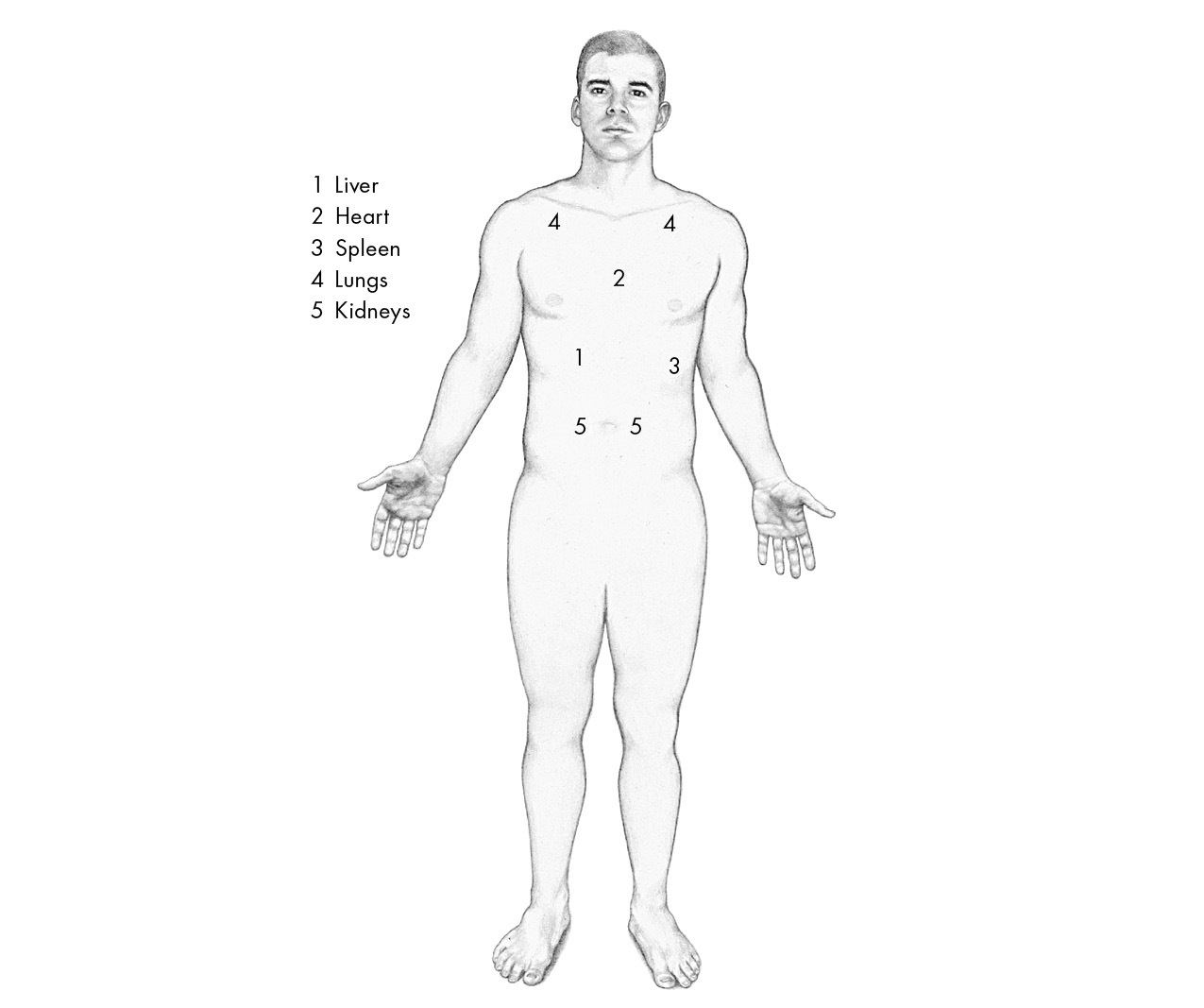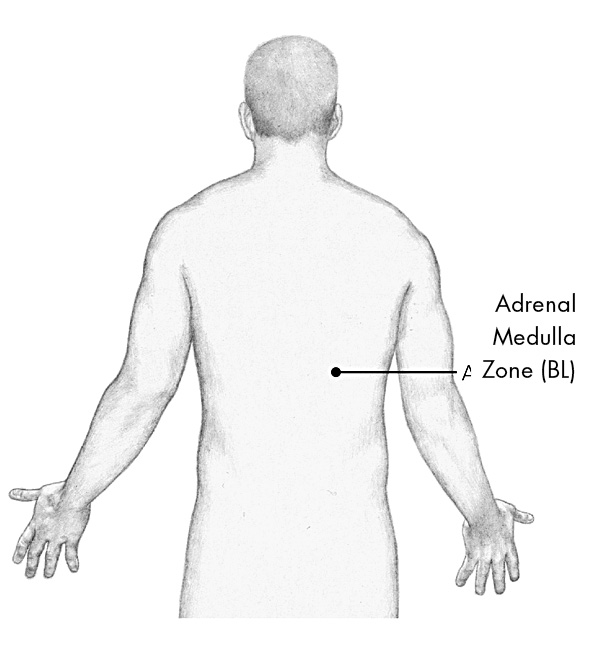Whole Health (19 page)
Authors: Dr. Mark Mincolla


FIGURE 5.4
Linking the Organs with Light
4.
Lungs to Kidneys:
Place your right hand over your lung and your left hand over your kidney. Picture a
blue light
being sent from your right hand (lungs) to your left hand (kidney). Hold the intention and vision in your mind for two minutes. Your lungs and kidneys are now light-linked.
5.
Kidneys to Liver:
Place your right hand over your kidney and your left hand over your liver. Visualize a beam of healing
green light
passing from your right hand (kidney) to your left hand (liver). Hold the intention and vision for two minutes. Your kidneys and liver are now light-linked.
This completes the Five Elements Vital Organ Cycle. You have now light-linked your vital organs in natural sequence from liver to heart, spleen to lungs, and kidneys to liver.
WENCHIECH'U
Wenchiech'u is the most powerful vehicle for energy balancing that I know of. It has virtually no limitations, and its effectiveness is faultless and time-tested. Powerful healing ch'i produces an energetic type of heat that is very different from the material heat that can be measured. There have been studies where scientists have noted a distinct warming effect produced by ch'i that can actually generate steam.
There are two forms of Wenchiech'uâcontact thermogenesis and noncontact thermogenesis. The contact form may only be performed “hands-on,” face-to-face. Noncontact Wenchiech'u, on the other hand, may be conducted nonlocally, over any distance. Even though it might seem like a paradox to our Western minds, noncontact or distance Wenchiech'u is much more powerful than the contact form, because energy that is transmitted at a distance masses, or collects energy, as it transits through space.
Wenchiech'u is a form of mental Qigong, which can be translated as “mind energy mastery.” Qigong is a 5,000-year-old energy healing discipline, represented by many distinct and varying forms. Generally, Qigong is the alignment of breath, movement, and awareness. However, the two most important elements in effective Qigong practice are willpower and concentration.
Ancient Chinese energy healers clearly understood that everything is energy, even thoughts. Thoughts that carry a powerful intention with intense concentration are among the most powerful manifestations of ch'i, and are most important for generating Qigong power. Similarly, Wenchiech'u demands the willpower of compassion, as well as great mental concentration, in order to be truly effective. So it all begins and ends with the practitioner's mind. Once the waves of concentration and healing intention are deeply set within the mind of the practitioner, Wenchiech'u healing may commence.
Concentration must be fixed on two intentionsâto stimulate deficient ch'i and to drain excessive ch'i. Remember, when evaluating energy, there are but three possibilitiesâexcess, deficiency, or balance. The goal of Wenchiech'u is to restore energy balance by adding to the deficiency and subtracting from the excess. There is always a drawstring effect with all ch'i imbalances. That is to say, when one area shifts out of balance due to excess, another corresponding area will become severely deficient.
The goal of the Wenchiech'u treatment will generally depend on the diagnostic energy assessment that preceded it. All the yin and yang organ systems that are deficient should be treated with warming, stimulating, counterclockwise spirals. All the organ systems with excess energy are to be balanced by energy-releasing clockwise spirals. As far as targeting exactly where practitioners are to direct their Wenchiech'u healing spirals, one may simply refer to the Wenchiech'u Treatment Zones charts (see Figure 5.5). These charts map all the major organ reference points. Once the subject's imbalances have been determined, the practitioner may direct Wenchiech'u spirals to the corresponding vital organ areas.
The best way to detect if a treatment is working is to diagnostically pulse test and retest the organ systems that have been treated. If the subject's arm drops, the organ is still deficient and requires more stimulation. If it pulses to a count between eight and ten, it should be considered balanced. If it pulses higher than ten, it is overstimulated and the excess energy should be released.
If the practitioner is in the physical presence of the subject, they can perform contact thermogenesis, which is a “hands-on” practice, either lightly touching the subject or positioning their action hand close to the subject while performing Wenchiech'u. If the subject is at a distance, however, practitioners must direct their noncontact Wenchiech'u intentions and actions nonlocally. Nonlocal Wenchiech'u is transmitted through mental intention from the practitioner's mind to the subject.
Nonlocal Wenchiech'u doesn't always have the benefit of a diagnosis. Therefore, practitioners should at least have a brief discussion with subjects to determine their patterns of imbalance (excess and deficiency). It should be noted here that a practitioner is not essential. One may practice Wenchiech'u on themselves by simply visualizing and directing clockwise and counterclockwise spirals to whatever areas of the body demand it. Here are a few pairs of common excess and deficiency patterns that occur together (see Figure 5.5A):
Excess EnergyâDeficient Energy
Virus (CV 7)âImmune system (Thymus Zone)
Allergies (ST 1)âLymph (Lung Zone)
Anxiety (stress) (PC 8)âAdrenals (Adrenal Medulla Zone)
Acid Reflux (CV 17)âStomach (Stomach Zone)

FIGURE 5.5 (a)
Excess/Deficiency Patterns

FIGURE 5.5 (b)
As one becomes more comfortable thinking about and working with energy, the complexities of excess and deficiency become a matter of common sense. The excess/deficiency chart above points this out. For example, let's look at the first figureâviral excess. Viruses are inflammatory events that generate fevers and heat. Therefore, like all forms of inflammation, viruses are a reflection of excess energy. But viral excess never initiates the imbalanceâinstead, immune system deficiency does that. Only when the protective immune system is deficient is a virus free to generate its debilitating excess energy. When it comes to viruses, practitioners would do well to spin clockwise spirals at CV 7 to release the excess viral energy and counterclockwise at the Thymus Zone to increase immune energy.
The same holds true for allergies, anxiety, and acid reflux, among other ailments. These conditions reflect inflammation, burning, heat, acidity, and obsessive worry. Clearly they are all representative of excess energy. As with viruses, however, we see a pattern where deficiencies open the door for excesses. For example, allergic inflammation (ST 1) begins with a blocked, deficient lymph system (Lung Zone) that can no longer filter toxins and allergens out of the blood. Similarly, the emotional and mental excesses of anxiety (PC 8) are initiated by acute stresses that exhaust the adrenal glands (Kidney Zone). And the pain and excess inflammation of acid reflux (CV 17) often begin with a severe digestive deficiency (Stomach Zone).
Another diagnostic option is to surrogate test for the subject following a brief conversation. Regardless of whether the subject is at a distance, practitioners may focus their attention on the intended subject, as they then test the surrogate in their presence with the help of their EMT Long Form. Whether performed locally or nonlocally, the results are consistently remarkable.
In either case, if a subject's given organ reveals deficient energy, the practitioner will want to stimulate it by circling their dominant
hand in counterclockwise motions to add much-needed energy. If the subject indicates excess energy, the practitioner should cool the subject down by motioning their hand in a clockwise direction. Always remember that the subject is the clock facing outward. This means that counterclockwise (strengthening energy) would circle to their right. Clockwise (draining energy) would circle to their left (see Figure 5.6). It is important to clarify that clockwise is yang and counterclockwise is yin. However, due to the fact that these are fluid and not static forces, each is always transitioning into the opposite. So clockwise is yang, which produces yin energy. Counterclockwise is yin, which produces yang energy. In this way, clockwise spirals release excess energy and counterclockwise spirals add to or rebalance deficient energy.

FIGURE 5.6
Wenchiech'u
I am often asked questions like “What if I accidentally spin the
spirals in the wrong direction, will I harm the subject?” No, you will not. Once the practitioner sets their intention, any spirals that may be accidentally transmitted in the wrong direction will automatically be corrected by the wave of intention. As already stated, willpower and concentration are the most important variables because they generate an intense wave of intention.
PAIN POINT WENCHIECH'U
In the event that you're finding it difficult to muddle through all the confusion of energy diagnostics and point-and-zone location, you always have the option of simply aiming your Wenchiech'u treatment at what I call the pain pointâthat is, wherever it hurts. Wenchiech'u is a single-action protocol, so there is no need to worry about where the excesses or deficiencies are, and no need to perform organ balancing. It's strictly about making pain stop where it's manifesting, not necessarily where it's rooted. For example, if your subject has an inflammatory headache, you'll want to circle your dominant hand counterclockwise around their head. Ask them exactly where the root of their pain is and try your best to zero right in on the focal point of their disharmony. This enables you to engage your healing intentions right away.
I am often asked how long it takes to perform a Wenchiech'u treatment and how long it generally lasts. Treatments should last no longer than two minutes and generally last for three weeks, depending on the acuteness of the subject's condition or disease. Acute conditions such as influenza viruses typically require daily boosting. Chronic conditions and diseases, even if severe, require less boosting and are generally fine to boost at three-week intervals. You can never do harm by overboosting! Regardless of human error, no wrong can come of Wenchiech'u. All human error and ill intention is automatically canceled out.